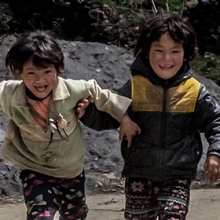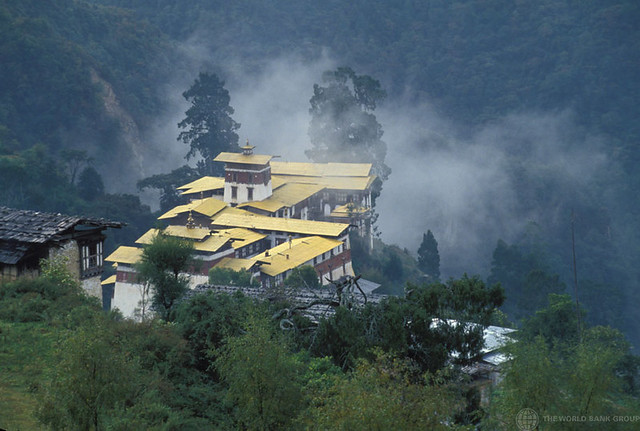At A Glance
A small, landlocked country nestled deep in the Himalayas between India and China, Bhutan is characterized by steep mountains and deep valleys, with scattered population settlement patterns. Since Bhutan shifted to a constitutional monarchy in 2008, the country has embarked on a development strategy rooted in the philosophy of Gross National Happiness (GNH).
Abundant water resources in the valleys create ideal conditions to tap renewal energy sources with hydropower development which has spurred economic growth with quasi universal access to low-cost electricity, free education and healthcare. Fiscal revenues from selling surplus hydropower to India and tourism windfall have helped the country invest substantially in human capital development. This has led to significant improvements in service delivery, education and health outcomes. Bhutan has made significant progress in reducing extreme poverty and promoting gender equality, with continuing efforts to address social inequality issues and regional disparities.
Bhutan aims to transform its economy through the 13th Five-Year Plan (FYP) and establishment of the Gelephu Mindfulness City. The 13th FYP, covering 2024-2029, focuses on addressing labor market inefficiencies and accelerating job creation by attracting FDIs and launching an ambitious economic stimulus program to reduce the continuous trend of outmigration. The country is exploring new drivers of growth in mining, forestry, high-value products for niche markets, creative industries, wellness tourism, etc. Gelephu Mindfulness City is an ambitious project aimed at transforming Gelephu Special Administrative Region into a regional magnet for business activity like in Singapore with the authenticity of Bhutanese culture, values and respect for biodiversity.
Country Context
Bhutan is a lower-middle income country, with GDP per capita of about $3,718. Economic growth contributed to poverty reduction during the decades preceding the Covid-19 pandemic. Extreme poverty ($2.15/day) was nearly eliminated, and those living below $3.65/day and $6.85/day dropped sharply. Remittances were crucial to improving welfare among recipient households. Remittances contributed to significantly reducing the poverty rate.. Poverty reduction was more salient in rural areas. Non-monetary well-being dimensions such as education and sanitation also improved. However, vulnerability to multi-hazard shocks and spatial inequalities persist, with the poverty rate ranging from 1.5 percent in Thimphu to 41 percent in Zhemgang. As measured by the Gini index, monetary inequality improved from 37 to 28, yet spatial disparities persist.
Bhutan maintains strong economic and strategic relations with India, its main trading partner, source of foreign aid as well as financier and buyer of surplus hydropower. While hydropower has provided a reliable source of revenue, non-hydro sectors which have been facing constraints related to the country’s challenging investment climate including high trade costs and a small domestic market, remain less competitive. The hydropower sector employs less than one percent of the labor force while the subsistence agriculture sector employs over 40 percent of the labor force. The lack of economic diversification and limited private sector activity pose risks to long-term growth and job creation. The COVID-19 pandemic exacerbated the labor market issues and contributed to the surge of outmigration. Youth unemployment rate, which was already high before the pandemic, stood at 19 percent in 2024.
Recent Economic Developments
The economy grew by 5.3 percent in FY23/24 (July 2023 to June 2024), supported by the recovery of the tourism sector and growth of the non-hydropower industry (base metals and ferro-silicon mining). The agriculture sector returned to the pre-pandemic growth rate of 3.4 percent after stagnating during the previous two fiscal years. The industry sector growth stalled at 0.2 percent, due to contraction in the hydropower and construction sectors, which combined accounted for 72 percent of the industry sector, despite strong growth in mining and quarrying sectors. The services sector grew by a robust 8.7 percent, led by a continuous recovery of tourism-related services.
Average inflation has continued to moderate from 8.2 percent in FY20/21 to 4.6 percent in FY21/22 and 4.3 percent in FY22/23. The decline in FY23/24 inflation is driven by both decline in food and non-food inflation in the last two months of FY23/24. The year-on-year (y-o-y) inflation for May and June 2024 drops to 2.2 percent and 1.8 percent, respectively. This is significantly below the average of 4.7 percent for the 10 months prior.
The fiscal deficit narrowed from 4.7 percent of GDP in FY22/23 to 0.8 percent in FY23/24, led by an increase of transfers from state-owned enterprises and a decline in total expenditures. Current expenditures increased due to a major salary hike for public servants ranging from 55 to 74 percent, aimed at curbing the high attrition rate of public servants. However, capital expenditure remained low in FY23/24, as most of the capital spending of the 12th FYP was frontloaded in FY20/21 to support the economic recovery following the Covid-19 pandemic.
The current account deficithas remained elevated at 22.7 percent in FY23/24, albeit significantly reduced from 34 percent in the previous year despite lower hydropower exports, due to a reduction in cryptocurrency mining related IT imports and continued recovery of the tourism sector. Hydropower exports declined despite the commissioning of the Nikachhu hydropower plant, due to increased domestic consumption, reflecting the higher electricity needs for energy-intensive cryptocurrency mining operations. Gross international reserves increased modestly to US$624 million in June 2024 (4.7 months of imports).
Economic Outlook
Economic growth is projected to increase in the short to medium term. The economy is projected to grow by 7.2 percent in FY24/25, driven by the industry sector due to a jump in electricity production from the commissioning of Punasangchu II hydropower plant as well as a gradual increase in mining (mineral products), manufacturing activities (base metals) and forestry. Growth is also supported by the services sector, including higher growth in tourism-related services, as the number of tourist arrivals is expected to return to pre COVID-19 level.
Inflation is projected to remain moderated in the medium term. Poverty reduction is expected to continue, with the $6.85/day poverty rate falling to 5.9 percent in FY24/25 and 5.0 percent in FY25/26. However, a substantial share of the population (19 percent of total population or 200,000) remains vulnerable to poverty due to multi-hazards risks, with nearly half of the poor exposed to landslides, severe weather patterns, earthquakes, GLOF, forest fires, droughts, etc.
The fiscal deficit is expected to widen before improving in the medium term with consolidation and rising revenues. The fiscal deficit is projected to increase to 4.4 percent in FY24/25, driven by increase in capital expenditure for the 13th FYP. Goods and Services Tax implementation and one-off profit transfers from commissioning of Punasangchu II in FY25/26, along with BTN 100 billion (US$1.2 billion) grant from the Indian government will boost revenue. Primary non-wage recurrent expenditure is expected to moderate.
Public debt will remains elevated, rising to 122 percent of GDP in FY25/26 but considered sustainable as most of it is linked to hydropower loans from India. These loans are implemented based on an intergovernmental agreement under which the Government of India covers financial and construction risks and commits to purchase all surplus electricity at a price reflecting cost plus a margin. However, rising debt service may limit the fiscal space for social spending.
The CAD is projected to decline to 17.5 and 9.3 percent of GDP in FY24/25 and FY25/26, before moderating further in the medium term. This is driven by continued reduction of cryptocurrency and hydropower plants construction related imports. Export is projected to grow with higher hydropower exports from the commissioning of Puna-II, increased non-hydropower (mining and timber), and tourism exports. As a result, international reserves are projected to increase to US$717 million in FY24/25 (5.1 months of import coverage).
The downside risks to the economic outlook persist. Delays in the commissioning of hydropower projects could affect growth, fiscal and external balances. Delayed fiscal consolidation and the possibility of financial sector contingent liabilities could further erode fiscal buffers, given that about 60 percent of assets of the financial sector are controlled by the public sector. Continued emigration of skilled labor continues to weigh on the economy and likely to have negative impact in the medium term.
Last Updated: Oct 17, 2024



